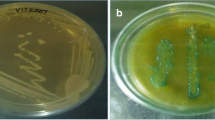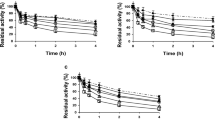Abstract
Disulfide reduction of Kluyveromyces lactis and Aspergillus oryzae β-galactosidases and β-lactoglobulin was assessed. Reduction was performed using one of two thiol-containing agents: dithiothreitol (DTT) or thiopropyl-agarose with a high degree of substitution (1000 μmol of SH groups/g of dried gel). Both reductants allowed an increase of three- (for K. lactis β-galactosidase) and fourfold (for A. oryzae β-galactosidase) in the initial content of SH groups in the lactases. Nearly sevenfold fewer micromoles of SH groups per milligram of protein were needed to perform the reduction of K. lactis β-galactosidase with thiopropyl-agarose than for the same reduction with DTT. However, for A. oryzae β-galactosidase, nearly twice as many micromoles of SH groups per milligram of protein were needed with thiopropylagarose than with DTT. Disulfide bonds in β-lactoglobulin were not accessible to thiopropyl-agarose, since this reduction was only possible in the presence of 6 M urea. These results proved that highly substituted thiopropyl-agarose is as good a reducing agent as DTT, for the reduction of disulfide bonds in proteins. Moreover, excess reducing agent was very simply separated from the reduced protein by filtration, making it easier to control the reaction and providing reduced protein solutions free of reductant. All these advantages substantially cut down the time required and therefore the cost of the overall process.
Similar content being viewed by others
References
Carlsson, J., Janson, J., and Sparrman, M. (1998), in Protein Purification: Covalent Chromatography, Janson, J. C. and Rydén, L., eds., Wiley-Liss, New York, pp. 403–405.
Hermanson, G. (1996), Bioconjugate Techniques, Academic Press Inc., San Diego.
Means, E., Feeney, R., and Robert, E. (1971), Chemical Modification of Proteins, Holden-Day Inc., San Francisco.
Carlsson, J., Batista-Viera, F., and Rydén, L. (1998) in Protein Purification: Covalent Chromatography, Janson, J. C. and Rydén, L., eds., Wiley-Liss, New York, pp. 343–373.
Ovsejevi, K., Grazú, V., and Batista-Viera, F. (1998), Biotechnol. Techniques 12, 143–148.
Singh, R. (1993), in The Chemistry of Functional Groups, Supplement S: The Chemistry of Sulphur-Containing Functional Groups, Patai, S. and Rappoport, Z., eds., Interscience, Chichester, England, pp. 633–657.
Axén, R., Drevin, H., and Carlsson, J. (1975), Acta Chem. Scand., Ser. B, 29, 471–474.
Brocklehurst, K., Carlsson, J., Kierstan, M., and Crook, E. (1973), Biochem. J. 133, 573–584.
Ellman, G. L. (1959), Arch. Biochem. Biophys. 82, 70–77.
Smith, P. K., Khron, R. I., Hermanson, G. F., Mallia, A. K., Gartner, F. H., Provenzano, M. D., Fujimoto, E. K., Goeke, N. M., Olson, B. J., and Klent, D. C. (1985), Anal. Biochem. 150, 76–85.
Author information
Authors and Affiliations
Corresponding author
Rights and permissions
About this article
Cite this article
Grazú, V., Ovsejevi, K., Cuadra, K. et al. Solid-phase reducing agents as alternative for reducing disulfide bonds in proteins. Appl Biochem Biotechnol 110, 23–32 (2003). https://doi.org/10.1385/ABAB:110:1:23
Received:
Accepted:
Issue Date:
DOI: https://doi.org/10.1385/ABAB:110:1:23




